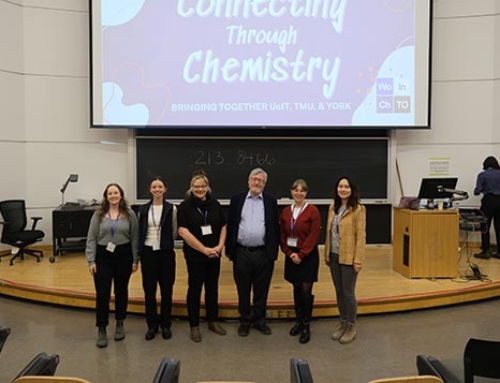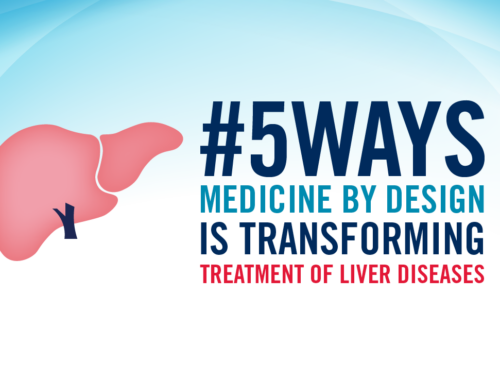
Ruonan Cao, PhD student at Alison McGuigan’s lab at the University of Toronto, holds a multi-well plate that is used as part of the lab’s new technology to scale up the study of cell behaviours. (Photo by Michael Martino.)
Inside every human are complex networks of trillions of cells. Now, research published recently in Advanced Healthcare Materials and supported by Medicine by Design’s Grand Questions program, has brought us closer to understanding that world.
“Cells behave just as people do. We act differently with different groups of people in different environments, like if you’re in a meeting at work you are different than when you’re lying on a beach with friends,” says Alison McGuigan, professor at the Department of Chemical Engineering & Applied Chemistry and the Institute of Biomedical Engineering at the University of Toronto (U of T).
Through a new technology that allows the researchers to watch single cell behaviour at scale they hope to gain a deepened understanding that could be the key to developing transformative new disease treatments in the future, McGuigan says.
A major aim of regenerative medicine is delivering new cells (also known as cell therapy) to replace or regenerate damaged or diseased ones. But the immune system will attack the cell therapy and destroy it unless the patient is heavily immune suppressed, which leaves the patient vulnerable to infections.
McGuigan sees a future where researchers can precisely program cell behaviour — in the context of regenerative medicine that might mean programming immune cells to not attack a cell therapy.
“We think this work would have a lot of applications including the ability to understand how to program immune cells, which could lead to powerful and safe regenerative medicine therapies,” McGuigan says.
The lead authors on this research are McGuigan lab members Ruonan Cao, PhD student, and Simon Latour, post-doctoral fellow. McGuigan lab researchers collaborated with researchers at the lab of Hartland Jackson at Lunenfeld-Tanenbaum Research Institute at Sinai Health.
McGuigan and her team were one of four projects awarded through Medicine by Design’s Grand Questions Program, which funds bold ideas and develops transformative and revolutionary solutions that will be of critical importance to regenerative medicine over the next 20 years.
“The Grand Questions funding on this research really allowed us to integrate technologies to amplify the work to a much higher value,” McGuigan says.
Video depicts the liquid robotic handler filling wells, which have tissue models inside, with a drug or compound. (Video provided by the McGuigan lab.)
BRINGING TOGETHER TISSUE ENGINEERING, SINGLE CELL ANALYSIS AND MACHINE LEARNING
The McGuigan lab makes highly effective 3-D models of human tissue,for example muscle tissue, that can be used to evaluate what happens when you give that tissue a drug or compound — how do the individual cell types react? How do they communicate with other cell populations? How does the environment the cells are in affect how the drug or compound works?
With trillions of cells in the body and countless drugs or compounds to test, this is painstaking work. Current testing methods using complex engineered tissues tend to be slow, perhaps testing 50 different treatments at one time at the most, and often are performed manually.
For this study, the McGuigan lab and their team set about automating this process using robots called robotic liquid handlers. The robots first fill 384-well dishes with a model of human tissue and then introduce a drug or compound to into each well.
The robot then “digests” the tissues — which means breaking it back into single cells — and barcodes those single cells from each well so they can be tracked during high-throughput single cell analysis. The barcoding technology was brought to the project from the Mark Nitz lab at U of T’s Department of Chemistry.
This type of single cell sequencing on a mass scale has historically been difficult.
This information can be fed into machine learning models to understand how each cell behaved in response to the drug. Long term, when enough data is generated, the machine learning model will be able to predict how to program specific cell behaviours — such as programming immune cells so that powerful regenerative medicine therapies can be used to treat disease.
SCALING UP THROUGH AUTOMATION
McGuigan says it’s the process the team developed, integrating the barcoding approach with automation and mass cytometry, a method to characterize the levels of different proteins in cells, that makes this work novel and powerful for single cell analysis.
“The scale of how many tissue samples can be evaluated at once is larger than anything out there now — our technology can do 384 samples at once,” says McGuigan. “And using a robot just makes everything more consistent and scalable.”
McGuigan says that initially, the team thought they would just focus on scaling and fabricating tissues, but after they brought in barcoding and sophisticated tissue analysis, it became much more ambitious.
“Because of the Grand Questions project, we were interacting with labs with these additional technologies, such as mass cytometry from the Jackson Lab . When it became clear that we could solve both the manufacturing and the analysis problem, we knew we would have a very powerful tool that hasn’t really been seen in the literature before.”
About Medicine by Design
Medicine by Design builds on decades of made-in-Canada excellence in regenerative medicine dating back to the discovery of stem cells in the early 1960s by Toronto researchers James Till and Dr. Ernest McCulloch. Regenerative medicine uses stem cells to replace diseased tissues and organs, creating therapies in which cells are the biological product. It can also mean triggering stem cells that are already present in the human body to repair damaged tissues or to modulate immune responses. Increasingly, regenerative medicine researchers are using a stem cell lens to identify critical interactions or defects that prepare the ground for disease, paving the way for new approaches to preventing disease before it starts. Medicine by Design is made possible thanks in part to a $114-million grant from the Canada First Research Excellence Fund.





